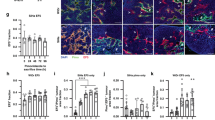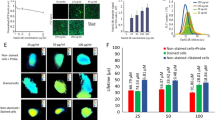Abstract
Pentoxifylline (PTX) has been shown to increase radiation damage to tumours and to decrease late radiation-induced injury to normal tissues. This tumour radiation sensitisation results from increased oxygen supply via improved tumour perfusion. We propose that the improved perfusion results from decreased viscous resistance and/or geometric resistance. The decreased flow resistance may be accompanied by a reduction in microvascular pressure (MVP). Since MVP is approximately equal to the interstitial fluid pressure (IFP), PTX should lead to a decrease in IFP. To test this hypothesis, we measured PO2, laser Doppler flow (RBC flux) and IFP in FSaII murine tumours at two doses (PTX at 25 and 100 mg per kg body weight) which sensitise this tumour to X-irradiation. We found that 25 mg kg-1 PTX was ineffective, but 100 mg kg-1 PTX was effective in increasing the PO2 of this tumour. PTX at 100 mg kg-1 (i.p.) increased median PO2 from 5 to 7 mmHg (P < 0.05) within 2 h, and decreased the fraction of PO2 values < 5 mmHg from 65% to 45% (P < 0.05). In support of our hypothesis, we found that with this dose of PTX, RBC flux in the tumour centre increased significantly (n = 6, P < 0.05) prior to an approximately 40% decrease (n = 13, P < 0.05) in tumour interstitial fluid pressure (TIFP), without changes in mean arterial blood pressure (MABP). In conclusion, a single i.p. administration of PTX at 100 mg kg-1 can increase oxygen availability in the tumour due to ameliorate hypoxia in tumour microregions. Second, PTX can lower the elevated TIFP without lowering the MABP.
This is a preview of subscription content, access via your institution
Access options
Subscribe to this journal
Receive 24 print issues and online access
$259.00 per year
only $10.79 per issue
Buy this article
- Purchase on Springer Link
- Instant access to full article PDF
Prices may be subject to local taxes which are calculated during checkout
Similar content being viewed by others
Author information
Authors and Affiliations
Rights and permissions
About this article
Cite this article
Lee, I., Boucher, Y., Demhartner, T. et al. Changes in tumour blood flow, oxygenation and interstitial fluid pressure induced by pentoxifylline. Br J Cancer 69, 492–496 (1994). https://doi.org/10.1038/bjc.1994.89
Issue Date:
DOI: https://doi.org/10.1038/bjc.1994.89
This article is cited by
-
Pressure increases PD-L1 expression in A549 lung adenocarcinoma cells and causes resistance to anti-ROR1 CAR T cell-mediated cytotoxicity
Scientific Reports (2022)
-
A numerical study on the effect of osmotic pressure on stress and strain in intercellular structures of tumor tissue in the poro-elastic model
Meccanica (2021)
-
Preventive Effect of Pentoxifylline on Acute Radiation Damage via Antioxidant and Anti-inflammatory Pathways
Digestive Diseases and Sciences (2010)
-
Inhibition of homologous recombination repair with Pentoxifylline targets G2 cells generated by radiotherapy and induces major enhancements of the toxicity of cisplatin and melphalan given after irradiation
Radiation Oncology (2006)
-
Studies on the mechanisms responsible for inhibition of experimental metastasis of B16-F10 murine melanoma by pentoxifylline
Journal of Biomedical Science (1999)



